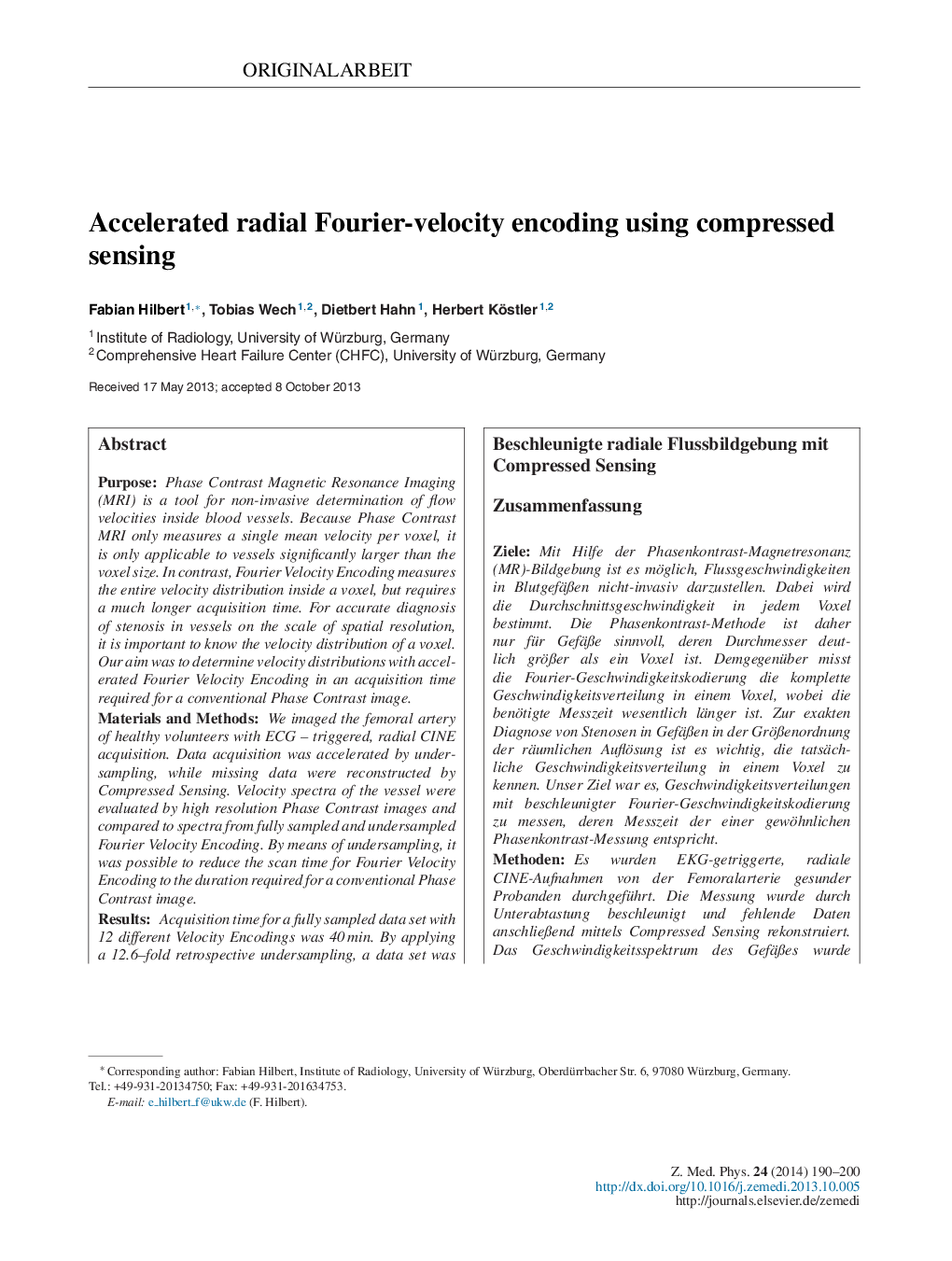| Article ID | Journal | Published Year | Pages | File Type |
|---|---|---|---|---|
| 1887978 | Zeitschrift für Medizinische Physik | 2014 | 11 Pages |
PurposePhase Contrast Magnetic Resonance Imaging (MRI) is a tool for non-invasive determination of flow velocities inside blood vessels. Because Phase Contrast MRI only measures a single mean velocity per voxel, it is only applicable to vessels significantly larger than the voxel size. In contrast, Fourier Velocity Encoding measures the entire velocity distribution inside a voxel, but requires a much longer acquisition time. For accurate diagnosis of stenosis in vessels on the scale of spatial resolution, it is important to know the velocity distribution of a voxel. Our aim was to determine velocity distributions with accelerated Fourier Velocity Encoding in an acquisition time required for a conventional Phase Contrast image.Materials and MethodsWe imaged the femoral artery of healthy volunteers with ECG – triggered, radial CINE acquisition. Data acquisition was accelerated by undersampling, while missing data were reconstructed by Compressed Sensing. Velocity spectra of the vessel were evaluated by high resolution Phase Contrast images and compared to spectra from fully sampled and undersampled Fourier Velocity Encoding. By means of undersampling, it was possible to reduce the scan time for Fourier Velocity Encoding to the duration required for a conventional Phase Contrast image.ResultsAcquisition time for a fully sampled data set with 12 different Velocity Encodings was 40 min. By applying a 12.6–fold retrospective undersampling, a data set was generated equal to 3:10 min acquisition time, which is similar to a conventional Phase Contrast measurement. Velocity spectra from fully sampled and undersampled Fourier Velocity Encoded images are in good agreement and show the same maximum velocities as compared to velocity maps from Phase Contrast measurements.ConclusionCompressed Sensing proved to reliably reconstruct Fourier Velocity Encoded data. Our results indicate that Fourier Velocity Encoding allows an accurate determination of the velocity distribution in vessels in the order of the voxel size. Thus, compared to normal Phase Contrast measurements delivering only mean velocities, no additional scan time is necessary to retrieve meaningful velocity spectra in small vessels.
ZusammenfassungZieleMit Hilfe der Phasenkontrast-Magnetresonanz(MR)-Bildgebung ist es möglich, Flussgeschwindigkeiten in Blutgefäßen nicht-invasiv darzustellen. Dabei wird die Durchschnittsgeschwindigkeit in jedem Voxel bestimmt. Die Phasenkontrast-Methode ist daher nur für Gefäße sinnvoll, deren Durchmesser deutlich größer als ein Voxel ist. Demgegenüber misst die Fourier-Geschwindigkeitskodierung die komplette Geschwindigkeitsverteilung in einem Voxel, wobei die benötigte Messzeit wesentlich länger ist. Zur exakten Diagnose von Stenosen in Gefäßen in der Größenordnung der räumlichen Auflösung ist es wichtig, die tatsächliche Geschwindigkeitsverteilung in einem Voxel zu kennen. Unser Ziel war es, Geschwindigkeitsverteilungen mit beschleunigter Fourier-Geschwindigkeitskodierung zu messen, deren Messzeit der einer gewöhnlichen Phasenkontrast-Messung entspricht.MethodenEs wurden EKG-getriggerte, radiale CINE-Aufnahmen von der Femoralarterie gesunder Probanden durchgeführt. Die Messung wurde durch Unterabtastung beschleunigt und fehlende Daten anschließend mittels Compressed Sensing rekonstruiert. Das Geschwindigkeitsspektrum des Gefäßes wurde in vollabgetasteten und unterabgetasteten Fourier-Geschwindigkeitsbildern bestimmt und anhand von räumlich hochaufgelösten Phasenkontrast-Bildern validiert. Mit Hilfe von Unterabtastung konnte die Messzeit der Fourier-Geschwindigkeitskodierung auf die gleiche Aufnahmedauer wie für ein konventionelles Phasenkontrast-Bild reduziert werden.ErgebnisseDie Aufnahmezeit für den voll abgetasteten Datensatz mit 12 unterschiedlichen Geschwindigkeitskodierungen betrug 40 min. Daraus wurde retrospektiv ein 12,6-fach unterabgetasteter Datensatz erstellt, der einer Messzeit von 3:10 min entspricht und somit die Dauer einer konventionellen Phasenkontrast-Messung hat. Die Geschwindigkeitsspektren der voll- und unterabgetasteten Fourier-Geschwindigkeitskodierung stimmen gut miteinander überein und entsprechen den Geschwindigkeiten im Phasenkontrast-Bild.SchlussfolgerungUnsere Ergebnisse zeigen, dass die Fourier-Geschwindigkeitskodierung die Geschwindigkeitsverteilung in Gefäßen in der Größenordnung eines Voxels exakt bestimmen kann. Darüber hinaus war es möglich, die fehlenden Daten einer unterabgetasteten Fourier-Geschwindigkeitskodierung mit Hilfe von Compressed Sensing zuverlässig zu rekonstruieren. Anstelle einer Durchschnittsgeschwindigkeit pro Voxel bei der Phasenkontrast-Messung kann mit der vorgestellten Methode das gesamte Geschwindigkeitsspektrum in jedem Voxel ohne zusätzliche Messzeit ermittelt werden.
